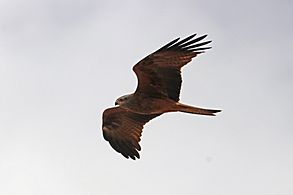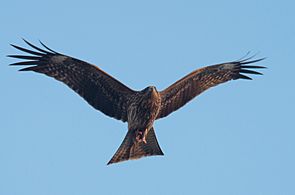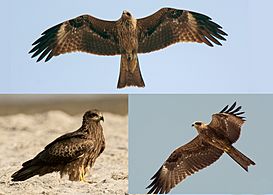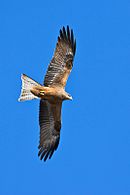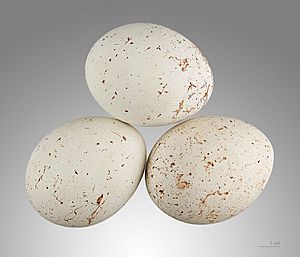Black kite facts for kids
Quick facts for kids Black kite |
|
|---|---|
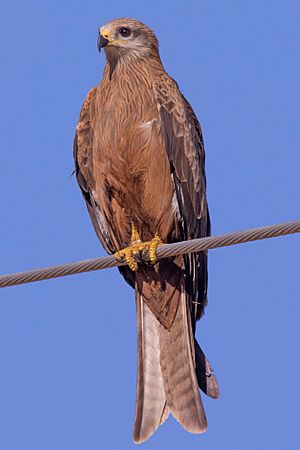 |
|
| M. m. affinis, Australia | |
| Conservation status | |
| Scientific classification | |
| Genus: |
Milvus
|
| Species: |
migrans
|
| Subspecies | |
|
5, see text |
|
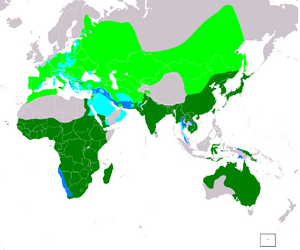 |
|
| Range of black and yellow-billed kites Breeding Resident Non-breeding Passage | |
| Synonyms | |
|
|
The black kite (Milvus migrans) is a medium-sized bird of prey. It belongs to the Accipitridae family, which includes many other birds of prey active during the day. It is believed to be the most common species in its family, even though some groups have seen big drops in numbers. There are about 6 million black kites around the world.
Unlike some other birds of prey, black kites often look for food that is already dead. They are also good at catching live prey when they get the chance. They spend a lot of time flying high and gliding on warm air currents to find food. You can easily spot them by their angled wings and a special forked tail. They also make a loud, whinnying call. This kite lives in many parts of Eurasia, Australasia, and Oceania. Kites living in cooler areas usually migrate, meaning they fly to warmer places for winter.
Contents
About the Black Kite's Name
The black kite was first described in 1770 by a French scientist named Georges-Louis Leclerc, Comte de Buffon. Later, in 1783, another scientist, Pieter Boddaert, gave it the scientific name Falco migrans. The word Milvus comes from Latin and means "red kite." The word migrans means "migrating," because these birds often travel long distances.
Sometimes, black kites can even breed with red kites. This has happened both in zoos and in the wild.
Recent studies of their DNA suggest that the yellow-billed kites in Africa might be a separate species. These African kites are found all over Africa, except in the Congo basin and the Sahara Desert.
Different Kinds of Black Kites (Subspecies)
There are several different types, or subspecies, of black kites. They live in different parts of the world and have slight differences in their looks or habits.
- M. m. migrans – This is the European black kite. It breeds in central, southern, and eastern Europe, and parts of Northwest Africa. It spends winter in Sub-Saharan Africa. Its head is usually lighter in color.
- M. m. lineatus – This is the black-eared kite. It lives from Siberia to Japan and parts of China and India. Birds from the north fly to South Asia in winter. This type has a larger pale patch on its wings.
- M. m. govinda – This is the small Indian kite. It lives in eastern Pakistan, India, Sri Lanka, and parts of Southeast Asia. These birds usually stay in one place. They are dark brown and often seen flying over cities. You can tell them apart by their slightly forked tail.
- M. m. affinis – This is the fork-tailed kite. It lives in Sulawesi, Papua New Guinea, and parts of Australia.
- M. m. formosanus – This is the Taiwan kite. It lives in Taiwan and Hainan and does not migrate.
What Black Kites Look Like
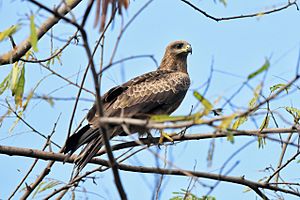
Black kites are a bit smaller than red kites. Their tail is less forked, and their feathers are generally dark brown, without the reddish color of red kites. Males and females look similar, but males are a little smaller.
Their upper feathers are brown, but their head and neck are often paler. They have a darker patch behind their eyes. The outer flight feathers are black. The lower part of their body is light brown. Their cere (the waxy part above the beak) and gape (the corner of the mouth) are yellow, but their beak is black. Their legs are yellow, and their claws are black.
Black kites make a special shrill whistle, followed by a quick whinnying sound. Their wingspan is about 150 centimeters (about 5 feet).
Where Black Kites Live
Black kites are found in Europe, Asia, Africa, and Australia. Kites living in cooler areas migrate to warmer places for winter. For example, birds from Europe and central Asia fly south for the colder months. But kites in warmer places, like India or Australia, usually stay in the same area all year.
Sometimes, black kites can wander far from their usual homes. For instance, a young black-eared kite was seen in England in 2006, which was unusual.
In India, there are many M. m. govinda kites, especially in cities. They avoid heavily forested areas. A study in New Delhi in 1967 found about 2,200 pairs of kites in a 150 square kilometer area. This means about 15 pairs per square kilometer!
How Black Kites Behave
Finding Food
Black kites are often seen gliding high in the sky, looking for food. They fly easily, changing direction with little effort. They swoop down with their legs ready to grab small live prey, fish, trash, or dead animals. Because they often eat dead animals, British soldiers sometimes call them "shite-hawks."
They are very good at finding opportunities to eat. They have been known to catch birds, bats, and rodents. They are also attracted to smoke and fires, where they look for animals trying to escape. Some native Australian stories even say that kites spread fires by picking up burning twigs to make prey run out.
In Indian cities, black kites are very used to humans. Large numbers fly over cities, and sometimes they will even swoop down to snatch food right out of people's hands!
Gathering and Roosting
In winter, black kites often gather in large groups to sleep together in what are called communal roosts. Before settling down for the night, many birds might fly around together. When they migrate, black kites are more likely to form big flocks than other birds of prey, especially before flying over large bodies of water.
Raising Young
In India, black kites start breeding in winter, usually in January and February. The young birds are ready to fly before the monsoon season. Their nest is a rough platform made of twigs and rags, usually placed in a tree. They might use the same nest site year after year. European kites breed in the summer.
Both the male and female kite help build the nest, sit on the eggs, and care for the chicks. They usually lay 2 or 3 eggs. The eggs hatch after about 30 to 34 days. In India, the chicks stay in the nest for almost two months. Young kites can breed after they are two years old.
Parent kites protect their nest and will dive at anyone who comes too close. They seem to remember people who bother their nests and will target them with dive attacks.
Dangers for Black Kites
Black kites sometimes sit on electric wires and can get hurt or killed by electrocution. They also get hit by cars when they swoop down to pick up dead animals on roads. Sometimes, many kites can be poisoned if they eat poisoned rodents in farm fields. They can also be a problem at airports because their size makes them a danger to planes.
Black kites are large birds of prey, so they don't have many natural enemies. However, the Eurasian eagle-owl (Bubo bubo) is a serious predator. Eagle-owls will catch kites of any age, from chicks to adults. When eagle-owls nest near kites, the kites have much less success raising their young. Like most birds, kites can also get parasites.
Images for kids
-
M. m. migrans, Spain
See also
 In Spanish: Milano negro para niños
In Spanish: Milano negro para niños



